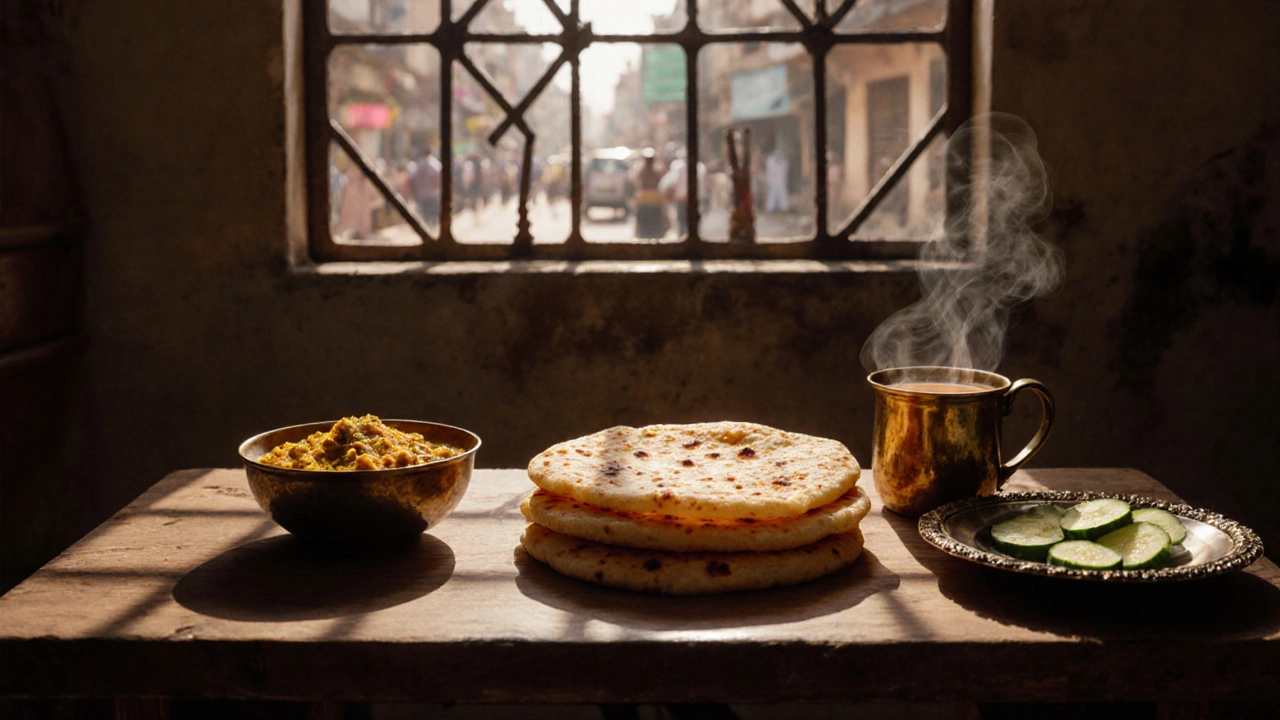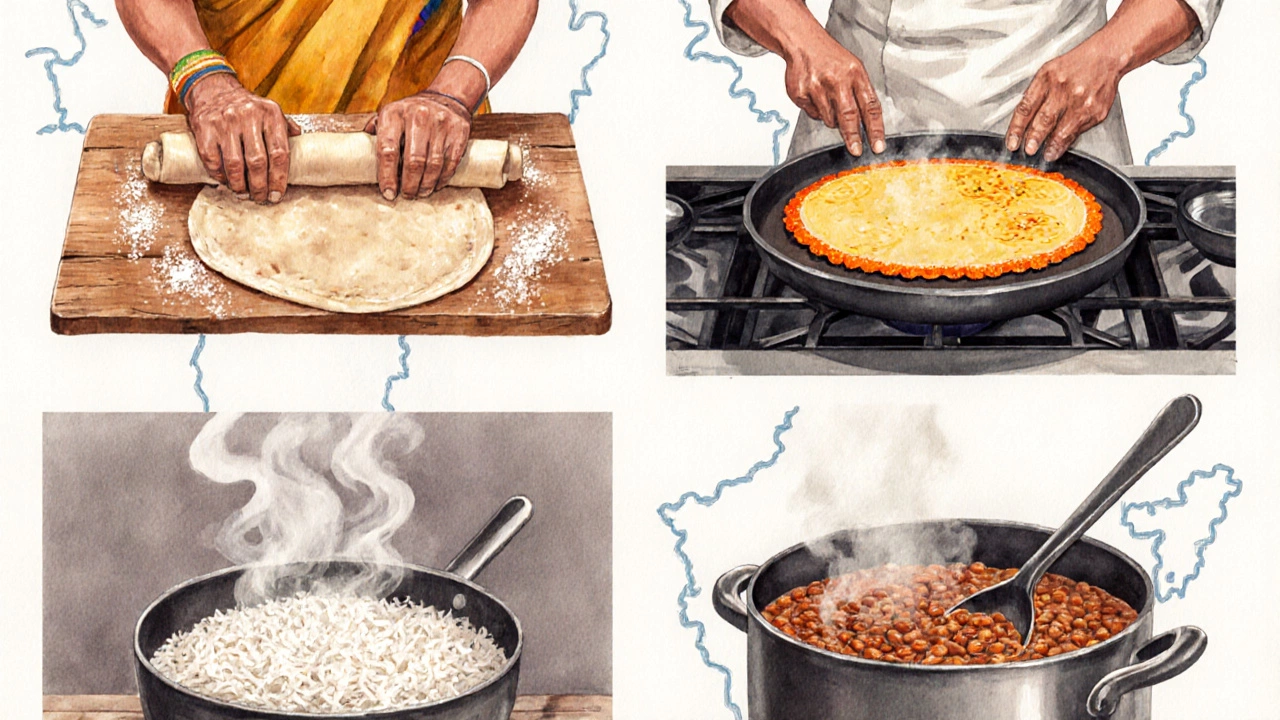What is the Most Popular Indian Dish? A Deep Dive into India’s Favorite Everyday Meal
 Oct, 13 2025
Oct, 13 2025
Indian Staple Food Consumption Calculator
Staple Food Calculator
Select your region to see average daily consumption of Indian staple foods compared to national averages.
When you think of everyday Indian meals, Roti is a thin, unleavened whole‑wheat flatbread that accompanies most dishes across the subcontinent. It shows up on breakfast plates, lunch thalis, and dinner tables from Delhi to Chennai. But is roti really the dish Indians eat the most? Let’s explore the numbers, the regional quirks, and why this humble bread often tops the list.
Why Indian Food Staples Matter
India’s culinary landscape is a patchwork of climates, cultures, and histories. A staple dish isn’t just a tasty side - it’s a cultural anchor that defines daily rhythm. Knowing the most‑eaten dish helps nutritionists, food‑service businesses, and home cooks plan menus that resonate with the majority.
Key Players: The Staples That Compete for the Crown
Four foods dominate Indian tables:
- Roti - whole‑wheat flatbread, common in North and Central India.
- Rice - steamed or boiled grains, essential in South, East, and many coastal regions.
- Dal - spiced lentil stew, served alongside both roti and rice.
- Masala Dosa - fermented rice‑and‑lentil crepe, iconic of South India.
While dal is a side, its daily presence is nearly universal, so we’ll weigh it too. The question is which of these reaches the highest per‑capita consumption.
What the Numbers Say (2024-2025 Surveys)
Two major sources give us a clear picture:
- The National Sample Survey Office (NSSO) 2024 food‑budget report, which tracks household grain purchases.
- A private market‑research firm’s 2025 "India Food Habits" study, covering 25,000 respondents across urban and rural areas.
Key findings:
| Staple | Daily Volume (grams) | Caloric Share (%) | Primary Regions |
|---|---|---|---|
| Roti (whole‑wheat) | 210 | 38 | North, Central, West |
| Rice (white/medium grain) | 180 | 33 | South, East, Northeast, coastal |
| Dal (lentils, split peas) | 70 | 12 | All regions |
| Masala Dosa | 55 (equiv. rice‑lentil batter) | 9 | South, major metros |
Roti edges out rice by about 30 grams a day, translating to roughly 5% more calories from this staple alone. The gap widens when you factor in the fact that many households consume both roti and rice in a single meal-yet the volume of roti remains the higher single item.

Regional Flavors: Where Roti Leads and Where Rice Rules
Even though roti wins nationally, the story varies by state:
- Punjab, Haryana, Uttar Pradesh - Average roti intake exceeds 250g per person; rice is occasional.
- Tamil Nadu, Kerala, West Bengal - Rice consumption tops 230g, while roti is limited to breakfast or special occasions.
- Maharashtra (urban) - A balanced mix; roti 190g, rice 170g.
- Northeast (Assam, Manipur) - Rice dominates (260g) due to local paddy cultivation.
These patterns are rooted in agriculture: wheat thrives in the Indo‑Gangetic plains, whereas rice flourishes in the humid south and east. Still, when you combine all states, the wheat‑based roti surpasses rice in total weight consumed.
How Roti Is Made: The Everyday Kitchen Routine
Understanding why roti is so popular starts with its simplicity. A basic recipe looks like this:
- Mix whole‑wheat flour (atta) with a pinch of salt and a little water.
- Knead into a smooth, non‑sticky dough (about 5minutes).
- Let the dough rest for 10minutes - this improves elasticity.
- Divide into golf‑ball‑size balls, roll each into a 6‑inch circle.
- Cook on a hot tawa or cast‑iron skillet until puffed and light brown on both sides.
The entire process takes under 5minutes per roti, requires no oil, and uses ingredients that cost less than a rupee per piece in most markets. This low cost and speed explain its ubiquitous presence.
Health Angle: Why the Nation Keeps Coming Back to Roti
Roti offers several nutritional perks that align with public‑health goals:
- Fiber content - Whole‑wheat atta provides 3g of fiber per 100g, aiding digestion.
- Low glycemic index - Compared with white rice, roti spikes blood sugar more gently.
- Protein balance - When paired with dal, the rice‑wheat combo delivers a near‑complete amino‑acid profile.
These benefits have been highlighted in studies by the Indian Council of Medical Research (ICMR) 2023, which linked regular roti‑dal meals with lower rates of type‑2 diabetes in northern states.
Quick Checklist: Is Roti the Right Choice for Your Menu?
- Target audience primarily northern or central Indian consumers? - Yes.
- Need a low‑cost, fast‑prep staple? - Yes.
- Cooking for vegans or vegetarians? - Perfect, as roti contains no animal products.
- Offering gluten‑free options? - No, consider rice or millet‑based flatbreads.
When these conditions align, roti often outperforms other dishes in acceptance and profitability.
Beyond the Crown: Other Beloved Dishes Worth Knowing
Even though roti claims the top spot, here are three dishes that regularly vie for “most‑eaten” status in specific pockets:
- Idli - Steamed rice‑and‑lentil cakes, especially in Karnataka and Andhra Pradesh.
- Pav Bhaji - Spiced vegetable mash with buttered buns, a Mumbai street‑food staple.
- Butter Chicken - Creamy tomato‑based chicken dish, beloved across urban India.
Each of these enjoys massive daily servings in their regions, but their aggregate national consumption still trails roti.
Bottom Line: The Most Eaten Dish in India
Putting the data, the regional spread, the preparation ease, and the health profile together, roti (whole‑wheat flatbread) emerges as the most popular Indian dish by sheer volume consumed per person across the country. Rice follows closely, especially in the south and east, but the national average keeps roti in the lead.
Frequently Asked Questions
What makes roti different from chapati?
In everyday usage the terms are interchangeable. Technically, "chapati" often refers to a thinner, softer roti cooked without oil, while some regional recipes call a thicker, puffed version simply "roti".
Is rice ever cooked the same way as roti?
No. Rice is boiled or steamed, whereas roti is baked on a dry skillet. The cooking techniques reflect the grain’s texture and moisture content.
How many rotis does an average Indian family eat in a day?
Based on the 2024 NSSO data, a four‑person household typically consumes 800‑900grams of roti per day - roughly 4‑5 medium‑sized rotis per person.
Can I substitute whole‑wheat roti with millet flour?
Yes, millet (like bajra or jowar) can be used to make gluten‑free flatbreads. The taste and texture differ, and the dough needs extra water, but the nutritional profile improves with higher calcium and iron.
Why do some Indians prefer rice over roti even in wheat‑rich regions?
Taste preference, a desire for variety, and meals that pair better with rice (like fish curries) drive the choice. Urban lifestyles also influence habits, with many families rotating both staples throughout the week.